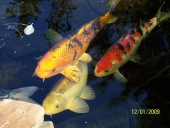




Idle dreamer








http://www.breezymeadowsorchards.com/learn/permaculture-design-course
Breezy Meadows orchard & Nursery Permaculture Design Course. Join us at our permaculture farm in the wilds of Tinmouth, VT. Hands on experience on a working farm that produces food 365 days a year.




jbreezy wrote:
This creates the illusion that your growing in a very small efficient space, but your using acres and acres of ocean and field to grow that food.

Idle dreamer




 :
:
Idle dreamer




 1
1






Idle dreamer








Idle dreamer








 My plan is to raise Red Wigglers and Black Soldier Fly larvae on "waste" from the household and garden. I also plan to collect "free range" Pillbugs and Sowbugs from my garden.
My plan is to raise Red Wigglers and Black Soldier Fly larvae on "waste" from the household and garden. I also plan to collect "free range" Pillbugs and Sowbugs from my garden.
Idle dreamer








































Check out my Primal Prepper blog where I talk about permaculture, prepping, and the primal lifestyle... all the time! 








Check out my Primal Prepper blog where I talk about permaculture, prepping, and the primal lifestyle... all the time! 












Check out my Primal Prepper blog where I talk about permaculture, prepping, and the primal lifestyle... all the time! 





SE, MI, Zone 5b "Opportunity is missed by most people because it is dressed in overalls and looks like work."
~Thomas Edison









Idle dreamer









Neal McSpadden wrote:
I've been thinking a lot about the feed issue since I'm moving to a new place and will be setting up a new AP system.
I keep coming back over and over again to the Aztec chinampas system. Plus add in other closed-output systems like worms and BSF larvae.
I think it could be a very-nearly closed system.
SE, MI, Zone 5b "Opportunity is missed by most people because it is dressed in overalls and looks like work."
~Thomas Edison









Perma Republican wrote:
is it possible to hook up the tanks to a well pump? how much water needs to come in?
thank you for sharing
SE, MI, Zone 5b "Opportunity is missed by most people because it is dressed in overalls and looks like work."
~Thomas Edison




Brad Davies wrote:
I also have been mulling over the idea of incorporating a chinampa system. I would like to be able to fence it and use it as a paddock system for the ducks I will eventually get. Maybe even use the land area in between as a rabbit / chicken paddock. Being on a semi island might keep the rabbits from burrowing away.
Check out my Primal Prepper blog where I talk about permaculture, prepping, and the primal lifestyle... all the time! 




Brad Davies wrote:
I believe the recommended water change for a recirculating aquaculture system (RAS) is 10% of the volume weekly. This could change based on stocking density as well as filter capacity. I had my sump hooked up with a float valve from the hose to make sure there was a constant water level. The only reason I drained mine ~30% - 50% was to water my veggie plots, approx. 1500sq ft worth.
An 8’ dia pool filled 2’ deep holds about 750gal or 100 cu feet. I have read stocking at 1lb of biomass to 1 cu foot of water is a good rule of thumb, but again there is a huge amount of variables to consider.
Next year I plan to run drip irrigation to my plots and run the pump on a timer, with that combined with the auto float valve from my hose I should be able to automate my water changes.
 ).
).Check out my Primal Prepper blog where I talk about permaculture, prepping, and the primal lifestyle... all the time! 




Idle dreamer





H Ludi Tyler wrote:
I think you'd have to filter the water first before running it through drip tubes, even if it's been filtered through a grow-bed, the water seems to have a pretty large quantity of particulates.
SE, MI, Zone 5b "Opportunity is missed by most people because it is dressed in overalls and looks like work."
~Thomas Edison








 I wonder if a little fan could be included to whack them down if they don't naturally fall....
I wonder if a little fan could be included to whack them down if they don't naturally fall....Idle dreamer





|
I'm thinking about a new battle cry. Maybe "Not in the face! Not in the face!" Any thoughts tiny ad?
Homestead Pigs Course
https://permies.com/wiki/365748/Homestead-Pigs
|

.jpg)

